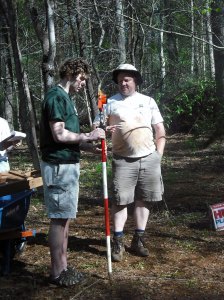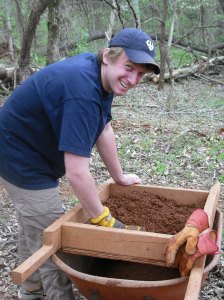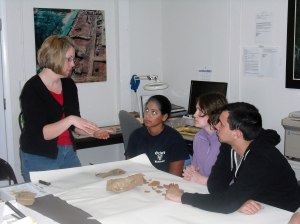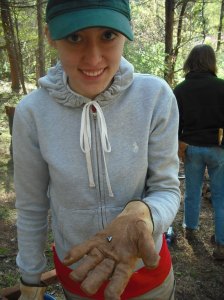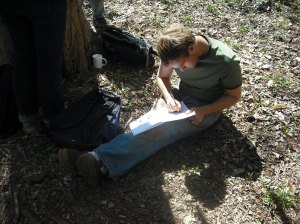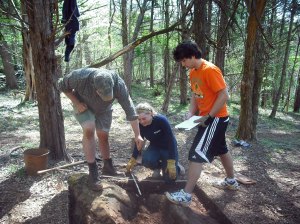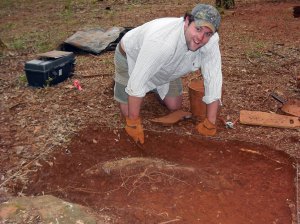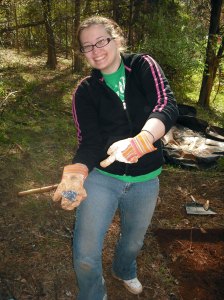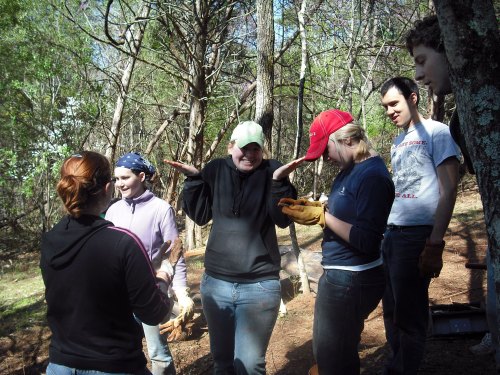
Makenzie Hatfield '12 and Collin Hayes '12 show artifacts to site visitors
Field Experiences
W&L students have gained both breadth and depth in exposure to archaeological field methods during recent weeks. Techniques and artifacts that were complete novelties to them three weeks ago are comfortably familiar now. At Monticello’s Site 17, students assess nails (machine cut vs. hand wrought) and ceramics (pearlware vs. creamware) and rocks (slate vs. phyllite vs. greenstone) with a combination of casualness and expertise that can only come from solid understandings. And now that all students have completed a number of excavation quadrats – executing each task from stringing out the new unit to excavating and recording it – they marvel that tasks such as profile drawing that once took them most of a day now require only part of an hour.

Erin Schwartz '12, Kathleen Ninan '11 and Susan Payton '11 drawing the profile of a wall in a quadrat they excavated
Field Trips

Preservation Virginia archaeologist Jamie May shows a newly unearthed artifact to W&L students and visitors
Students have also enjoyed a pair of field trips to very different sites: Jamestown Island and Monasukapanough. The former is the well-known English fort established in 1607 and under investigation by Preservation Virginia; the latter is a seventeenth-century Monacan Indian village near Charlottesville, currently being excavated by University of Virginia archaeologists. W&L students were amazed by the volume, antiquity, and completeness of many artifacts from Jamestown – including nearly whole stoneware jugs excavated from a well (c. 1618-1611) on the day of our visit – and by the fine, loamy soil on the site of the flood plain at Monasukapanough. That sediment provides a marked contrast to the red loamy clay (or just clay) through which W&L students have been digging at Monticello’s Site 17.

Tyler Thompson '11 and Monticello archaeologist Don Gaylord watch Alex Massey '10 take site elevations using a total station
Today it rained and rained and rained.” Colin Hayes ‘12
The wet weather has been an interesting challenge for the W&L dig. Some days the rain was steady; other days it was unpredictable. One evening Ian Dexter ’12 noted in his journal, “Rain took our group by complete surprise when it erupted upon us at 2:00 this afternoon.” Other days have been sunny but still muddy from previous wet ones, as Aleisha Butler ’10 commented: “Today was dirtier, in its way, than yesterday. The mud had a life of its own.” Richard Hahn ’11 observed that the back dirt pile – where the screened soil goes – had become “sludgy and unpleasant.” Probably an understatement.

Richard Hahn '11 and Susan Payton '11 compare a sediment sample to a Munsell Color Chart
The students’ ability to maintain positive attitudes – even joking about sliding down the site’s slope and into each other while troweling their quadrats – is a great testament to them. The course professors have also been amused and gratified to hear the students making jokes that include archaeological topics such as Munsell numbers. Munsell color charts – used to describe soil hue, chroma and value – becoming familiar enough to serve as punch lines is a sure sign of a successful archaeological education.

Tyler Thompson '11 and Monticello archaeologist Don Gaylord examine an artifact
Finds
The dig has also continued to be fun and educational because of the artifacts that Site 17 keeps yielding. Little compares to the excitement of unearthing artifacts in the field, although several students have commented on the satisfaction of working with artifacts in the lab too. As Danielle Maurer ’12 put it one afternoon, “The best part of the day was our session cleaning artifacts in the lab. Lab work, while lacking the thrill of discovery inherent in field work, is very nice because one gets to see all the artifacts from the site, and to see them clean.”

Monitcello archaeologist Sara Bon-Harper considers a newly excavated iron artifact with Kathleen Ninan '11
Artifacts students have recovered from Site 17 recently include English ceramics such as creamware and transfer-printed pearlware, dark green (“wine”) bottle glass, colorless table glass – the most exciting being a large, cut stem from a glass – iron hardware (one likely being a hinge), lead shot, and copper alloy buttons. Sophomore Kathleen Ninan noted, “I found two more large pieces of Chinese export porcelain today. At first I was excited because I thought they might mend with the sherd I found yesterday, but it was even cooler to realize actually how different they all were.”
Visitors
As the field season begins drawing to a close, the number of visitors to the site has begun increasing. The site open house is Friday, May 22; people interested in visiting should notify Professor Alison Bell (434-760-3160 or bella@wlu.edu) or students enrolled in the class (who will pass the information on to Prof. Bell).

Visiting students from Faith Primary School in Waynesboro screening soil for artifacts
We were also delighted one afternoon to host kindergartners and first graders from Faith Primary School in Waynesboro, Virginia. Collin Neal said that “highlights of my day included a visit from a bunch of five year olds who helped screen some sediment. They kept handing me rocks. I thought it was cute so I just kept letting them do it but I felt kind of bad for their parents and teachers because all of their hands and clothing were pretty dirty from the nice wet clay!”

Aleisha Butler '10 shows an artifact to a visiting kindergartener











